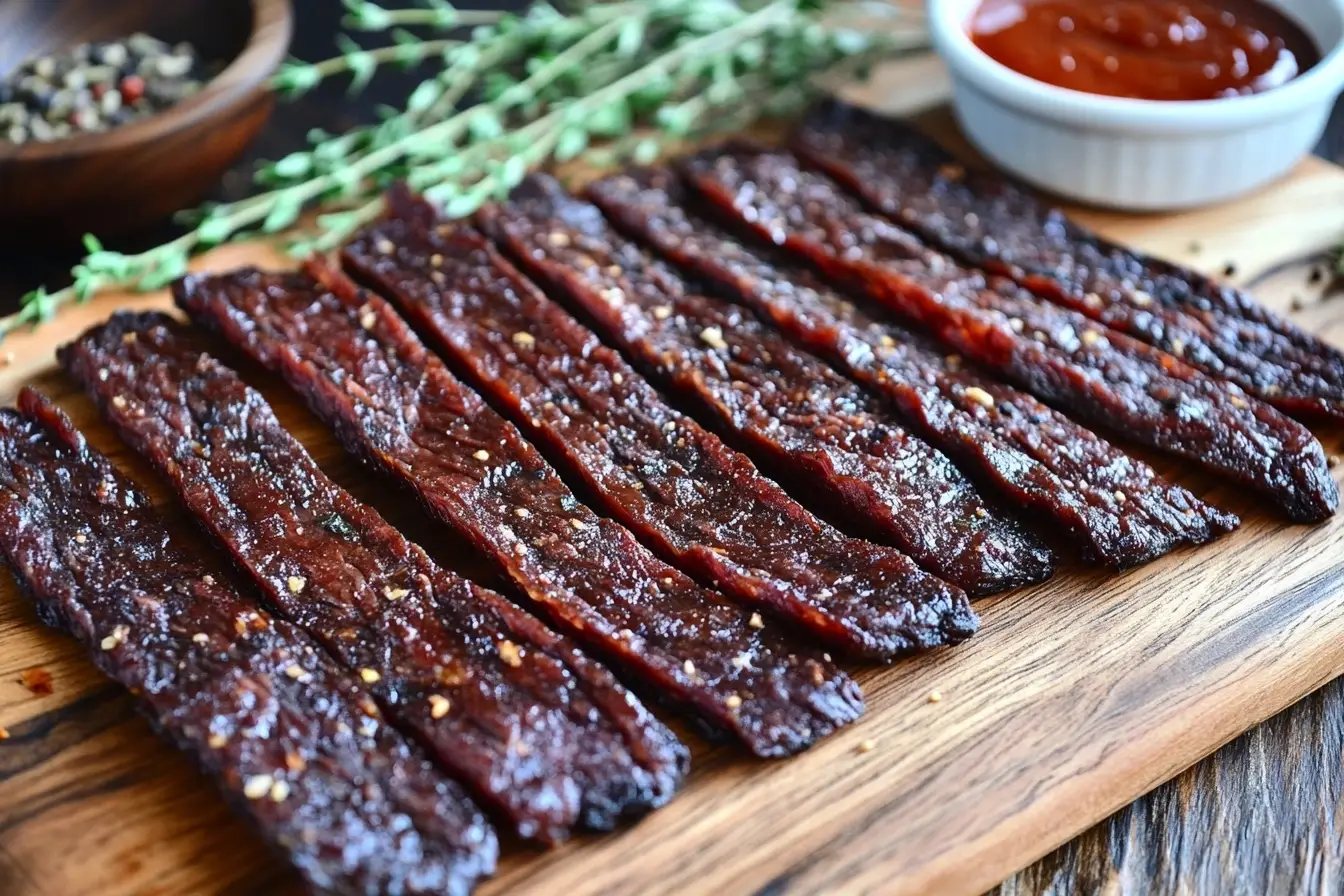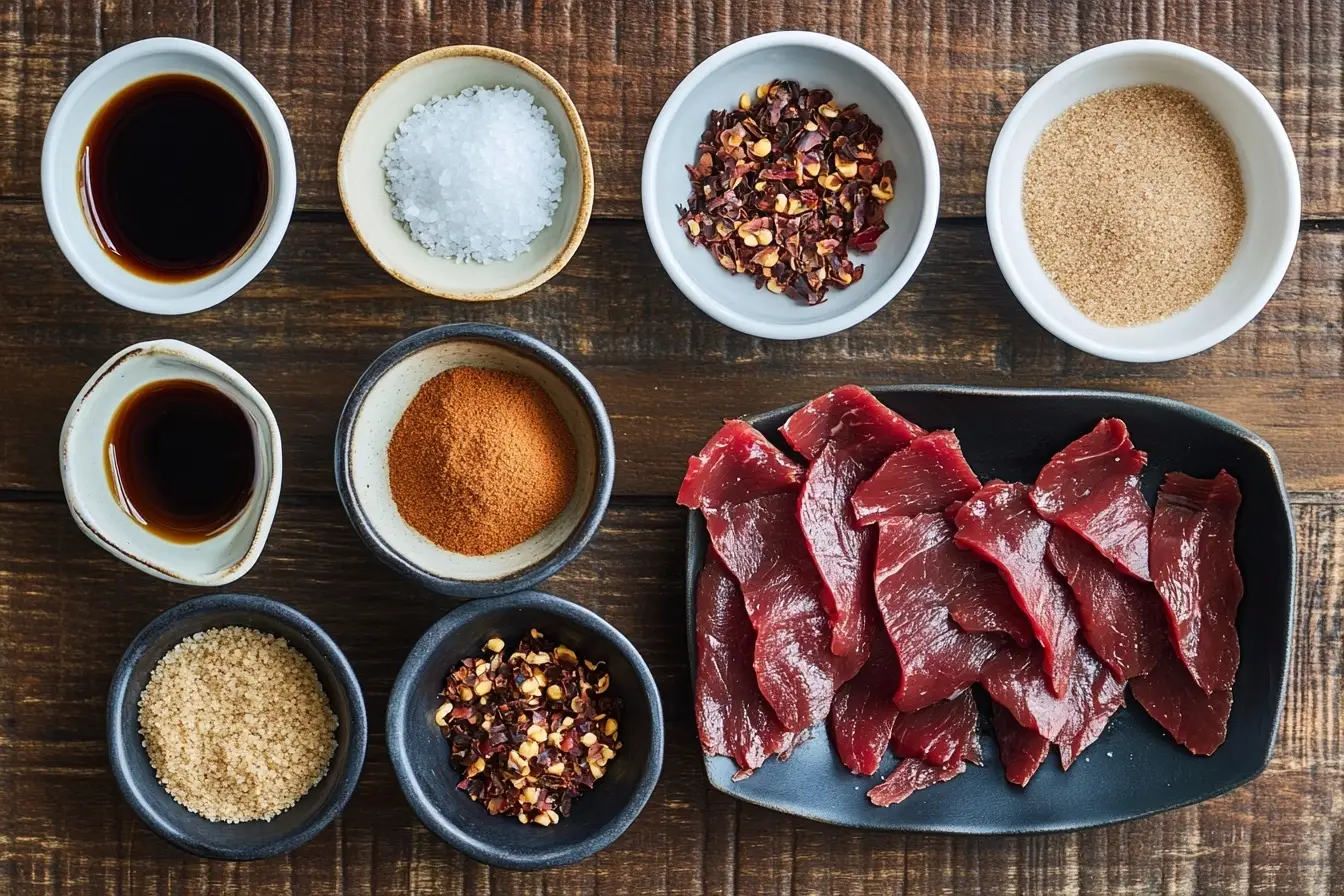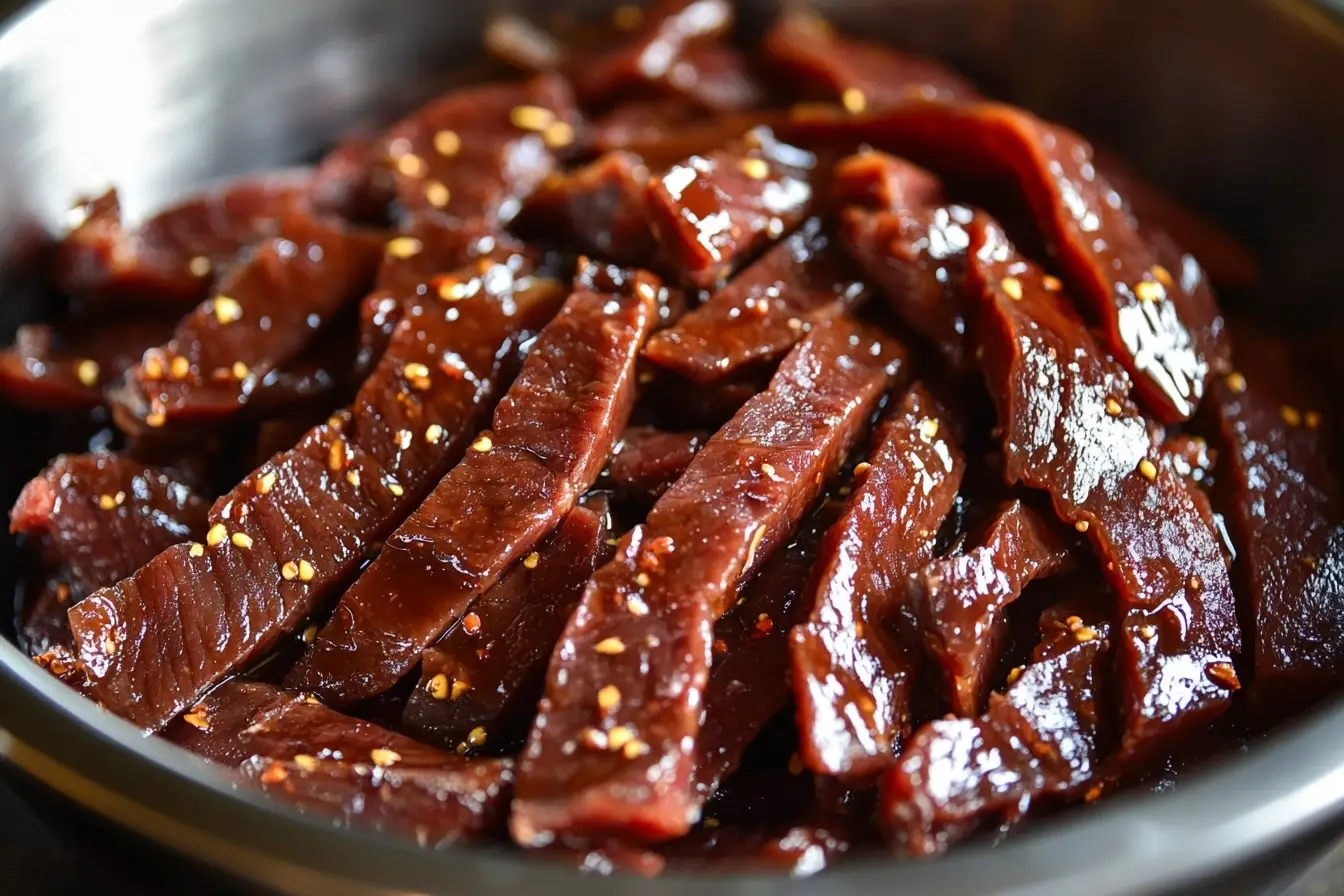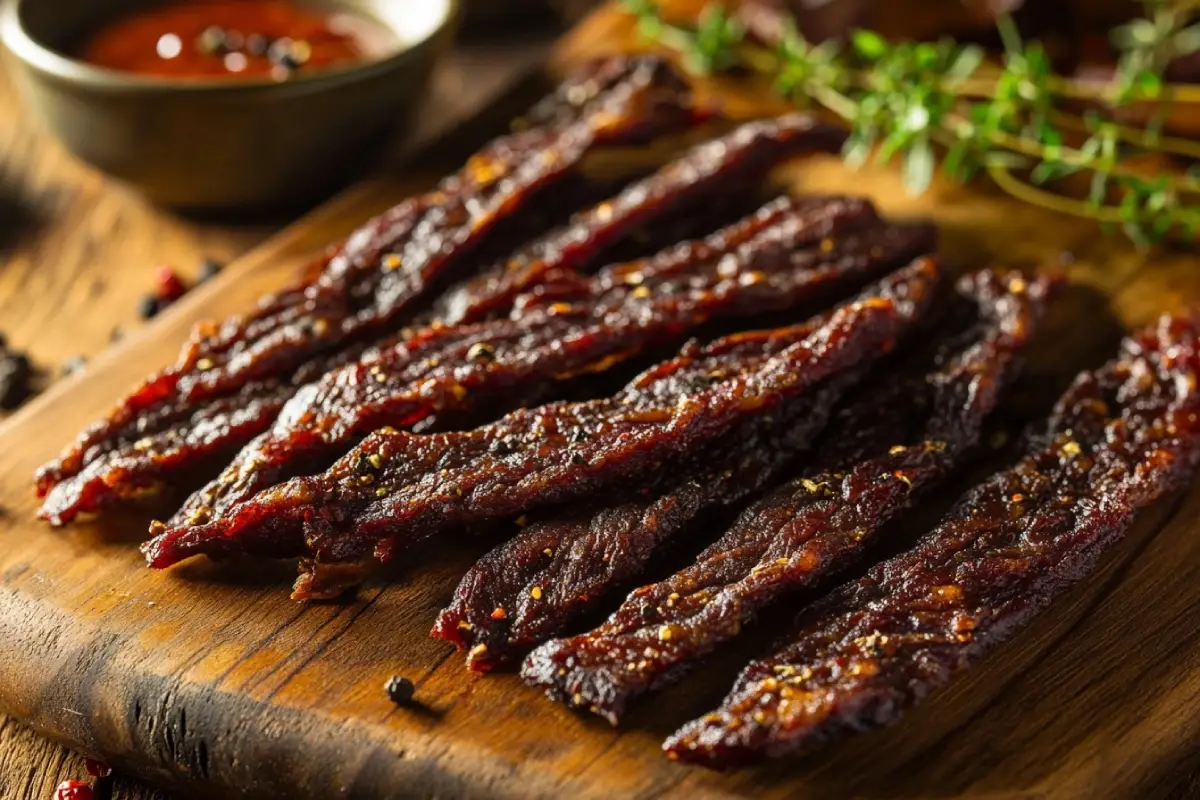In this guide, you’ll learn how to make delicious homemade beef jerky recipe. You’ll find out the key ingredients and how to do it step by step. Whether you’re new to jerky or already love it, this article will help you become a pro at making beef jerky.
Key Takeaways
- Discover the benefits of making your own beef jerky recipe at home
- Learn how to choose the right cut of beef for the perfect jerky texture
- Explore classic marinade recipes and unique flavor combinations
- Understand the step-by-step process of slicing, marinating, and dehydrating the beef
- Unlock tips for proper storage and shelf life of your homemade beef jerky
Introduction: Why Make Your Own Beef Jerky?
Starting your own beef jerky journey has many benefits. You get to choose every ingredient, making your snack taste better and be of higher quality. This is something store-bought jerky can’t offer.
The Benefits of Homemade Jerky
- Customize the flavor profile to your exact preferences
- Avoid preservatives, additives, and artificial ingredients found in many commercial jerky brands
- Save money by using affordable cuts of beef and creating your own unique blends
- Enjoy the satisfaction of mastering a traditional preservation technique
A Brief History of Jerky
Jerky has been around for thousands of years. Ancient people dried meat to keep it fresh. This snack was a hit with Native American tribes and South African biltong lovers.
Today, jerky is more popular than ever. Home cooks and artisanal producers love its rich history and flavor options.

“Homemade jerky allows you to control the ingredients, ensuring a healthier, more flavorful snack that’s tailored to your personal tastes.”
The Essential Ingredients
To make the perfect homemade beef jerky, start with the right ingredients. The marinade and seasonings add flavor, but the best cuts of beef for jerky are key. Knowing the beef jerky ingredients and how to pick the right jerky meat selection is crucial.
Choosing the Right Cut of Beef
For best cuts of beef for jerky, some are better than others. Look for lean, flavorful cuts that stay tender during dehydration. Popular choices include:
- Flank Steak
- Sirloin Tip
- Top Round
- Eye of Round
- Bottom Round
These cuts are lean and flavorful, perfect for jerky. Choose cuts with little marbling or connective tissue for a tender final product.
| Cut of Beef | Characteristics |
|---|---|
| Flank Steak | Lean, flavorful, and ideal for jerky |
| Sirloin Tip | Tender, with a slightly higher fat content than other cuts |
| Top Round | Lean, with a firm texture that holds up well to dehydration |
By choosing the right beef jerky ingredients and jerky meat selection, you’ll make delicious homemade beef jerky.

Preparing the Marinade
Making the perfect beef jerky marinade is key to delicious homemade jerky. You can stick to a classic recipe or try new flavors. The goal is to mix savory, sweet, and spicy just right.
Classic Marinade Recipes
A traditional jerky marinade uses soy sauce, Worcestershire sauce, brown sugar, and spices. This mix gives a deep, umami flavor that goes well with beef. Just mix these ingredients and let the beef soak up the flavors before drying.
Experimenting with Unique Flavor Combinations
While classic marinades work great, feel free to mix things up with your homemade beef jerky. Try adding honey or maple syrup for sweetness. Or, use crushed garlic, ginger, or chili peppers for spice.
For an Asian twist, add teriyaki sauce, sesame oil, or rice vinegar. For a smoky taste, try smoked paprika, cumin, or chipotle powder. The world of how to marinate beef for jerky is full of possibilities. Find the marinade that suits your taste best.

Slicing and Marinating the Beef
Getting your beef ready for drying is key to making great homemade jerky. Learning how to slice beef for jerky and marinating beef for jerky is crucial. It helps get the right texture and taste.
Start with a good cut of beef, like flank steak or top round. Use a sharp knife to cut the beef into thin strips. These should be about 1/4 to 1/2 inch thick. This jerky slicing technique makes the jerky even and lets the marinade soak in well.
- Slice the beef into thin, even strips, approximately 1/4 to 1/2 inch thick.
- Cut the strips across the grain of the meat for the best texture.
- Trim off any excess fat or connective tissue to prevent uneven drying.
Now, marinate the beef. Make your marinade and make sure the flavors spread evenly. Let the beef soak for at least 4 hours. Or, for even more flavor, marinate it for up to 24 hours. Make sure to turn the beef often so it gets covered evenly.
“Marinating the beef is the key to unlocking a world of jerky flavor possibilities. Experiment with different spices, herbs, and liquids to create your own signature blend.”
With the beef sliced and marinated, you’re all set. Now, start drying it to turn it into delicious homemade beef jerky.
Dehydrating the Marinated Beef
After marinating your beef, it’s time to dry it into tasty homemade beef jerky. You can use the oven or a food dehydrator. Each method has its own benefits, so let’s look at them.
Oven Dehydration Method
The oven method is easy and accessible for making how to dehydrate beef jerky at home. Lay the marinated beef slices on a baking sheet or wire rack without overlapping. Set your oven to 135°F (57°C) and dehydrate for 4-8 hours, flipping the slices a few times. This will help you get the right dryness.
Using a Dehydrator
If you prefer a more precise drying process, a food dehydrator is the better choice. Dehydrator beef jerky dries more evenly due to consistent temperature and airflow. Just follow the dehydrator’s instructions, placing the beef slices on the trays and setting the temperature to 155°F (68°C). Dehydrate for 4-8 hours until it’s dry and chewy.
| Oven Dehydration | Dehydrator |
|---|---|
| Lower temperature (135°F/57°C) | Higher temperature (155°F/68°C) |
| Longer drying time (4-8 hours) | Shorter drying time (4-8 hours) |
| Less consistent drying | More consistent drying |
| More accessible, uses a common kitchen appliance | Requires a dedicated food dehydrator |
Choose the method that works best for you. Just keep an eye on the jerky and adjust the time and temperature as needed. With a bit of practice, you’ll become a pro at making oven beef jerky recipe!
Beef Jerky Recipe: Step-by-Step Guide
Making your own beef jerky is a fun and rewarding project. You can make it taste and feel just how you like. Follow this guide to make tasty homemade beef jerky that will make your taste buds happy.
- Choose the perfect cut of beef. For the best homemade beef jerky recipe, pick lean and tasty cuts like flank steak, top round, or eye of round.
- Make the marinade by mixing your favorite seasonings, spices, and acids. Try teriyaki, garlic, and black pepper, or make your own special how to make beef jerky step by step flavor.
- Cut the beef into thin strips, no thicker than 1/4 inch. This helps it dry out well.
- Put the beef strips in the marinade, cover, and chill for at least 4 hours, or up to 24 hours. This lets the flavors soak into the meat.
- Heat your oven to its lowest setting, about 135°F (57°C). Lay the marinated beef strips on baking sheets, making sure they don’t touch.
- Let the jerky dry in the oven for 4-8 hours, flipping it a few times. You can also use a homemade beef jerky recipe dehydrator for better results.
- When the jerky is ready, let it cool down completely. Then, store it in a sealed container or bag. Enjoy your tasty, how to make beef jerky step by step homemade snack!
| Ingredient | Quantity | Purpose |
|---|---|---|
| Beef (flank steak, top round, or eye of round) | 2 lbs (900g) | Main ingredient for the jerky |
| Soy sauce | 1/2 cup (120ml) | Marinade flavor and tenderization |
| Worcestershire sauce | 1/4 cup (60ml) | Marinade flavor |
| Brown sugar | 2 tablespoons (30g) | Marinade sweetness |
| Garlic powder | 1 teaspoon (5g) | Marinade flavor |
| Black pepper | 1 teaspoon (5g) | Marinade flavor |
“Homemade beef jerky is a game-changer. Once you taste the fresh, flavorful results, you’ll never go back to store-bought again.”
Storing Your Homemade Beef Jerky
Keeping your homemade beef jerky fresh and flavorful is key for a great snack. Proper packaging and knowing the shelf life of your jerky are important. They help you store beef jerky well and safely.
Proper Packaging and Shelf Life
To keep your homemade jerky fresh, pack it right. Use airtight containers, resealable bags, or vacuum-sealed pouches. These options keep air, moisture, and contaminants out, preventing spoilage.
The shelf life of beef jerky depends on how it’s dried, what’s in it, and where you store it. Generally, well-packaged and stored jerky can last:
- Room temperature: 2-4 weeks
- Refrigerator: 2-3 months
- Freezer: 8-12 months
For the longest freshness, package your jerky in small portions and freeze it. This keeps your snacks tasty and fresh for longer.
| Storage Method | Shelf Life |
|---|---|
| Room Temperature | 2-4 weeks |
| Refrigerator | 2-3 months |
| Freezer | 8-12 months |
By following these tips on how to store beef jerky, you can enjoy your homemade jerky for weeks or months.
Variations and Flavor Twists
Take your homemade beef jerky to the next level with new flavors. Try sweet and spicy or the classic teriyaki beef jerky. This section offers ideas and recipes to match your taste.
Sweet and Spicy Jerky
Love a mix of sweet and spicy? Try a sweet and spicy beef jerky flavor. Use a basic marinade and add brown sugar or honey for sweetness. Then, add cayenne pepper, chili powder, or hot sauce for a kick.
Teriyaki Beef Jerky
The teriyaki beef jerky is a hit with everyone. Marinate beef in soy sauce, brown sugar, garlic, and ginger. It’s tender and full of umami flavor.
Check out beef jerky flavor ideas and find your favorite snack. Sweet, spicy, or both, the choices are endless when you make your own.
Pairing and Serving Suggestions
Make your homemade beef jerky even better with the right pairings and serving ideas. Try different drinks and side dishes to bring out the bold flavors of your jerky.
Looking for what to eat with beef jerky? A cold beer, hard cider, or zesty lemonade can be a great match. For a healthier choice, pair it with a smoothie full of fruits and veggies.
For how to serve beef jerky, think outside the box. Serve it on a wooden board with cheese, dried fruits, and nuts for a stunning jerky snack ideas platter. You can also add it to salads, wraps, or as a potato topping.
“Jerky is the perfect grab-and-go snack, but it can also be elevated to an impressive appetizer or a unique ingredient in a variety of dishes.”
Beef jerky is super versatile, so don’t be afraid to try new things. Mix and match flavors and presentation styles to enjoy your homemade jerky to the fullest.
Safety Considerations
Keeping your homemade beef jerky safe and of high quality is key. Learning about food safety guidelines helps you enjoy your jerky without worry. You won’t have to worry about getting sick or finding contaminants.
Food Safety Guidelines
For beef jerky safety, handling, storing, and preparing it right is vital. Here are some important tips:
- Use clean, sanitized equipment for making and drying the jerky.
- Make sure the meat’s internal temperature hits at least 160°F (71°C) during drying. This kills harmful bacteria.
- Keep the finished jerky in an airtight container at room temperature. Keep it away from sunlight or heat.
- Eat the jerky within 1-2 weeks for the best taste and safety.
For ground meat jerky, extra care is needed to stop Clostridium botulinum growth. This bacterium is very dangerous. It’s safer to use whole muscle cuts instead of ground meat for jerky.
By sticking to these food safety guidelines for homemade jerky, your jerky-making will be tasty and safe. You and your family can enjoy it without worry.
“Proper food handling and storage are essential for ensuring the safety and quality of homemade beef jerky.”
Conclusion
Making your own homemade beef jerky has many benefits. You can choose what goes into it and make it taste just how you like. Plus, there’s the joy of making something tasty from scratch.
You now know how to make the perfect marinade, cut the beef right, and dry it to jerky perfection. These skills will make you a pro at making homemade jerky. You can try out classic flavors or get creative with new ones.
When you start making jerky, remember to keep it safe and store it right. This article has tips to help you make sure your jerky is not only delicious but also safe to eat. So, get your ingredients ready, turn on your dehydrator, and start making jerky. Your taste buds will thank you!
